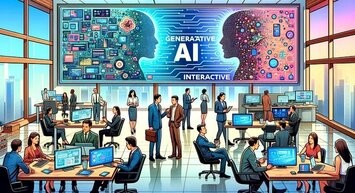- Getting Started with Generative Artificial Intelligence
- Mastering Image Generation Techniques with Generative Models
- Generating Art with Neural Style Transfer
- Exploring Deep Dream and Neural Style Transfer
- A Guide to 3D Object Generation with Generative Models
- Text Generation with Generative Models
- Language Generation Models for Prompt Generation
- Chatbots with Generative AI Models
- Music Generation with Generative Models
- A Beginner’s Guide to Generative Design
- Video Generation with Generative Models
- Anime Generation with Generative Models
- Generative Adversarial Networks (GANs)
- Generative modeling using Variational AutoEncoders
- Reinforcement Learning for Generation
- Interactive Generative Systems
- Fashion Generation with Generative Models
- Story Generation with Generative Models
- Character Generation with Generative AI
- Generative Modeling for Simulation
- Data Augmentation Techniques with Generative Models
- Future Directions in Generative AI
Interactive Generative Systems | Generative AI
Introduction
Artificial intelligence and interactive computing are combined to create Interactive Generative Systems (IGS), which let people modify and shape AI's output. These systems are capable of producing a wide range of material, such as text, music, photos, and virtual worlds. By including user feedback and input, they further obfuscate the distinctions between artificial intelligence and human innovation. IGS provides a fresh method for ideation, prototyping, and user testing and has applications in creative design, product development, art, and entertainment. This course will examine real-world examples, activities, and materials to assist users in realizing the possibilities of IGS.
Importance of Interactive Generative Systems
Artificial Intelligence and computer-generated content are transforming human-computer interaction via Interactive Generative Systems (IGS). IGS encourages collaborative creativity, tailored experiences, and effective design processes by fusing AI with interactive computing. Users are able to actively engage in the creative process, which promotes creativity and increases involvement. IGS democratizes creativity by making it available to people of all backgrounds and ability levels.
What are Interactive Generative Systems?
Imagine a system that can paint a picture based on your description. You could tell it you want a landscape with rolling hills, a babbling brook, and a quaint cottage. The system would then use its knowledge of art and landscapes to generate a unique painting that matches your desires. This is a simplified example of an IGS.
IGS combine two key aspects:
Generative AI: These systems can recognize patterns and produce new material, such as writing, music, or graphics, since they have been trained on enormous volumes of data.
Interactive Systems: Users may direct the generating process and provide feedback via IGS. Real-time feedback, choice selection, and explanation provision are just a few ways to do this.
Why are Interactive Generative Systems Interesting?
IGS holds immense potential for various applications. Here are a few examples:
- Creative Design: Imagine using an IGS to brainstorm design ideas or generate variations on existing concepts.
- Product Development: An IGS could help create prototypes or explore different product features based on user input.
- Art and Entertainment: IGS could create interactive art experiences or personalized stories based on user preferences.
Generative AI vs Interactive AI

Generative AI primarily focuses on content generation without direct user interaction. It learns patterns from data and generates content autonomously.
Interactive AI, in contrast, is designed for user engagement. It responds to user inputs and queries, making it suitable for applications like customer support, virtual assistants, and recommendation systems.
What is Generative AI?

In generative AI, neural networks are used to produce new data or content. An example of this kind of AI is OpenAI's GPT-3 model, which produces writing that is very similar to human language.
Real-World Applications
Generative AI has many diverse uses in both artistic and practical domains. It is essential in many real-world situations in addition to content creation and language translation. such as:
- Artistic Creation: Generative AI is used to create original artwork, such as paintings and musical compositions. For example, AI-generated art produced using programs like Mid Journey has become well-known in the art world, with pieces selling for high prices at auction.
- Drug Discovery: Generative AI is used by pharmaceutical researchers to simulate and suggest possible chemical compounds with medicinal qualities, therefore speeding up the drug development process. As a result, less time and money are needed for medication development.
- Content Personalization: Online content platforms utilize generative artificial intelligence (AI) to personalize ads and suggestions to each user, increasing user happiness and engagement.
Future Trends
It is expected that generative AI will lead to major breakthroughs in a number of fields, including journalism, literature, software development, and the arts. It might provide creative answers for challenging technical challenges, help authors produce drafts, and create symphonies with a human-like creative spark.
What is Interactive AI?

A category of artificial intelligence known as interactive AI, which includes chatbots and virtual assistants, seeks to improve human-machine interaction by reacting to user inquiries to create lively dialogues.
Real-World Applications
Enhancing user experiences and offering tailored services, interactive AI is essential to many real-world applications. Some noteworthy examples include:
- Customer Support: Chatbots powered by interactive AI answer questions, fix problems, suggest products, and provide real-time customer support to businesses like Microsoft and Amazon.
- Virtual Healthcare Assistants: In the healthcare industry, interactive artificial intelligence is being used to develop virtual healthcare assistants that can make appointments, monitor patient health, and offer medical advice.
- Content Recommendation: Interactive AI is used by streaming services like Netflix and music providers like Spotify to make content recommendations based on the tastes of specific users. Users are satisfied and engaged with this personalized suggestion system.
Future Trends
Virtual assistants such as Siri and Alexa will give way to more conversational, contextual, and sympathetic systems as interactive AI continues to advance.
When interactive AI is tailored to the emotions and preferences of its users, it has the potential to have a big influence on sectors like healthcare by providing companionship and emotional support to people who are lonely or experiencing mental health problems.
Conclusion
Artificial intelligence and interactive computing are combined to create Interactive Generative Systems (IGS), which let users influence the creative process and customize AI-generated products to their tastes. This promotes collaboration and democratizes the creative process. Software development, the arts, journalism, and literature can all be revolutionized by gender-driven AI, while the healthcare industry can benefit from interactive AI's ability to improve user experiences and offer customized treatments. Virtual assistants may eventually help people emotionally as they develop.
A new era of human-computer connection, cooperation, and creativity is being ushered in by Interactive Generative Systems (IGS), which combine generative and interactive AI.
